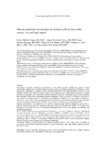Human amniotic mesenchymal stromal cells as favorable source for cartilage repair

Ver/
Use este enlace para citar
http://hdl.handle.net/2183/19523Coleccións
- GI-TCMR - Artigos [131]
- INIBIC-TCMR - Artigos [102]
- INIBIC- REUMA - Artigos [184]
Metadatos
Mostrar o rexistro completo do ítemTítulo
Human amniotic mesenchymal stromal cells as favorable source for cartilage repairAutor(es)
Data
2017-01-10Cita bibliográfica
Muiños-López E, Hermida-Gómez T, Fuentes-Boquete I, de Toro-Santos J, Blanco FJ, Díaz-Prado SM. Human amniotic mesenchymal stromal cells as favorable source for cartilage repair. Tissue Eng Part A. 2017;23(17-18):901-912
Resumo
[Abstract]
Introduction: Localized trauma-derived breakdown of the hyaline articular cartilage may progress toward osteoarthritis, a degenerative condition characterized by total loss of articular cartilage and joint function. Tissue engineering technologies encompass several promising approaches with high therapeutic potential for the treatment of these focal defects. However, most of the research in tissue engineering is focused on potential materials and structural cues, while little attention is directed to the most appropriate source of cells endowing these materials. In this study, using human amniotic membrane (HAM) as scaffold, we defined a novel static in vitro model for cartilage repair. In combination with HAM, four different cell types, human chondrocytes, human bone marrow-derived mesenchymal stromal cells (hBMSCs), human amniotic epithelial cells, and human amniotic mesenchymal stromal cells (hAMSCs) were assessed determining their therapeutic potential.
Material and Methods: A chondral lesion was drilled in human cartilage biopsies simulating a focal defect. A pellet of different cell types was implanted inside the lesion and covered with HAM. The biopsies were maintained for 8 weeks in culture. Chondrogenic differentiation in the defect was analyzed by histology and immunohistochemistry.
Results: HAM scaffold showed good integration and adhesion to the native cartilage in all groups. Although all cell types showed the capacity of filling the focal defect, hBMSCs and hAMSCs demonstrated higher levels of new matrix synthesis. However, only the hAMSCs-containing group presented a significant cytoplasmic content of type II collagen when compared with chondrocytes. More collagen type I was identified in the new synthesized tissue of hBMSCs. In accordance, hBMSCs and hAMSCs showed better International Cartilage Research Society scoring although without statistical significance.
Conclusion: HAM is a useful material for articular cartilage repair in vitro when used as scaffold. In combination with hAMSCs, HAM showed better potential for cartilage repair with similar reparation capacity than chondrocytes.
Palabras chave
Amniotic membrane
Chondrocytes
Bone marrow mesenchymal stromal cells
Cartilage
Amniotic mesenchymal stromal cells
Osteoarthritis
Cell therapy
Tissue engineering
Chondrocytes
Bone marrow mesenchymal stromal cells
Cartilage
Amniotic mesenchymal stromal cells
Osteoarthritis
Cell therapy
Tissue engineering
Versión do editor
Dereitos
Final publication is avaliable from Mary Ann Liebert, Inc. publishers.
ISSN
1937-3341
1937-335X
1937-335X





